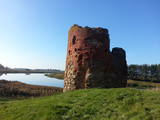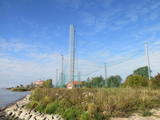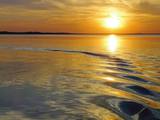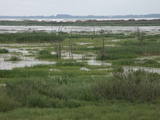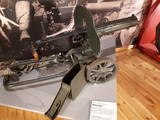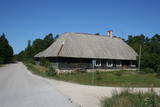| Нo | Название | Описание |
|---|---|---|
|
Наивысшая точка в южной части Даугавпилса – в окрестностях улицы 18-го Ноября, где на сравнительно небольшой территории в радиусе ~ 0,3 км находятся церкви четырех конфессий – храм Даугавпилсской Новостроенской старообрядческой общины (1908 – 1928), Даугавпилсский православный кафедральный собор святых благоверных князей Бориса и Глеба (1905), Римско-католическая церковь Пресвятой Богородицы (1905) и Кафедральный собор Мартина Лютера (1893). |
||
|
Смарде - старинное место, которое упоминается в документах XIII века. В наши дни - это небольшой поселок с железнодорожной станцией и магазином. К северо-востоку от Смарде, в Смардском болоте находится бывшее место добычи торфа. В Первую мировую войну недалеко от Смарде проходила линия фронта, о чем свидетельствуют находящиеся в окрестностях места памяти. |
||
|
Pankūku kafejnīca. Dažādi oriģināli pildījumi. Kafejnīca piedāvā svaigi grauzdētu kafiju, kafijas un alkoholiskos dzērienus, kā arī uzkodas. Atvērta tipa virtuve. |
||
|
Пилтене – это один из самых малых и древних городов Латвии. В исторических источниках Пилтене первый раз было упомянуто в 1295-м году, а стутус города был получен уже в 1557-м году. В период с 14-й по 16-й века Пилтене было административным центром Курляндского епископства. На исторических улицах, которые полукругом окружают руины замка, сохранилась деревянная застройка первой половины 19-го века. Пилтенский епископский замок был построен на рубеже 13-14 веков и использовался до 16-го века. До сего дня сохранился только фундамент и фрагменты башни на берегу Вецвенты. |
||
|
Моленная Малтской (Боровской) старообрядческой общины является
культурно-историческим памятником. Строительство храма началось в
1931, построен архитектором А. Грунцевичем.
|
||
|
Place for bird ringing and bird watching. |
||
|
Trušu audzēšanas saimniecība "Trušu muiža" savā allaž tapšanas procesā esošajā garaušu muižas kompleksā piedāvā aplūkot 15 – 20 dažādu šķirņu trušus no visas pasaules, kā arī iegūt bildi ar trusi. Lieliska iespēja ciemoties trušu "Harmonijas un miera sētā", tos samīļot, pabarot. "Trušu muiža" iegūst aizvien jaunus kaimiņus un pilnveidojas. Iespēja iegādāties "Trušu muižas" greznumlietas. Vaislas truši un mīļdzīvnieki. Vasaras sezonā (jūnijs - augusts) gaidīs ciemos no otrdienas līdz svētdienai (11:00 – 18:00). Lielākas grupas, iepriekš vienojoties, uzņem arī citā laikā. |
||
|
Озеро Разна (57,8 кв.км), называемое народом морем Латгалии, по
вместимости воды самое большое в Латвии и находится на возвышенности Латгалии, на пригорках
Разнава. В живописной окрестности озера поднимаются самые высокие вершины Латгалии и латгальские
городища. На берегах озера находятся излюбленные места отдыха горожан. Чтобы уберечь и сохранить
уникальный комплекс природы, создан Национальный парк Разна, а территория включена в сеть Natura
2000 защищаемых территорий Европейского союза. В озере 10 островов, 2 залива. Уровень воды озера –
163,8 м над уровнем моря.
|
||
|
Сельское хозяйство "Чай Рукишу" является одним из крупнейших производителей лекарственных растений в Латвии. Предприятие обеспечивает качество продукции путем выращивания и сбора растений в своем хозяйстве, а также путем тщательной сушки, хранения и упаковки. В процессе производства не используются какие-либо ароматизаторы, красители или загустители. Туристическим группам также предлагают дегустацию вкусного чая и советы по выбору чая. Желающие имеют возможность приобрести продукцию по привлекательным ценам в магазинчике производства. В хозяйстве выращивают большое количество самых разнообразных растений, из которых изготавливают чаи - зверобой, валериану, эхинацею, котовник кошачий, календулу, ромашку, тимьян, мелиссу, мяту, пустырник, васильки, полынь и т. д. Сюда особенно стоит заглянуть во время цветения растений, когда каждый кусочек поля окрашивается в свой, характерный только для него, тон. |
||
|
The Lake Lubāns depressions which are alongside the lake’s western and south-western parts feature little-changed forests and swamps, where many rare and protected birds nest. Many uncommon and protected habitats are in the region.
|
||
|
Образовалось в 60-х годах прошлого столетия, когда Советская армия пыталась ограничить рыболовство в районе побережья. Лодки не использовались и были оставлены в прибрежных дюнах. По дороге к кладбищу лодок с наружной стороны просматривается Большой сарай сетей. |
||
|
Atrodas 4,5 km ziemeļos no Rīgas – Daugavpils šosejas (A 6), klajā laukā (ap 3 m augsts, ainavisks). Viens no izcilākajiem Latvijas muldakmeņiem, tādēļ ir vērts izmest kādu loku. Akmens augšdaļā ir iekalts gandrīz 2 m garš un ~ 20 cm dziļš muldveida iedobums. Atrodamas ziņas, ka vēl 19. gs. vidū pie akmens ir ziedots ēdiens, monētas u.c. priekšmeti. Pie tā dedzināti ugunskuri un svinēti svētki. Teikas vēsta, ka velns muldā lējis ūdeni un gribējis mīcīt mīklu, kā arī parāvis zem akmens tuvējo māju saimnieku. |
||
|
Старинный хутор, хозяева которого занимаются пчеловодством. По запросу выезжают с образовательной программой в школы и на различные мероприятия. |
||
|
Маршрут ведет по природному парку «Излучины Даугавы», который в восьмидесятых годах прошлого века хотели затопить, построив Даугавпилсскую ГЭС. Центральной артерией природного парка является древняя долина Даугавы. Особенность Даугавы – восемь больших излучин реки, протяженность которых составляет 4 – 6 км. Наибольшую высоту берега реки достигают в т.н. «Воротах Даугавы», где возвышаются крутые и мощные Верверский и Слутишкский обрывы. Более половины территории занимают леса, подходящие для походов и наблюдения за природой, сбора ягод и грибов. Долина Даугавы – одна из флористически богатейших в Латвии. Здесь произрастают более 800 видов растений. Это край мультинациональной среды, где сплелись традиции латгалов, литовцев, поляков, русских и белоруссов и их наследие. Одно из излюбленных туристических мест – деревня Слутишки, единственная такого рода в Латвии. Maršruta informācija no Latvijas Lauku foruma |
||
|
Ikšķiles vārds Pirmā pasaules kara laikā izskan saistībā ar diviem notikumiem – Ikšķiles priekštilta nocietinājumiem (Nāves sala) un kaujām pie Mazās Juglas upes. 1917. gadā 1. septembra rītausmā Vācijas impērijas armija uzsāka uzbrukumu iepretim Ikšķilei ar mērķi ieņemt Rīgu un saņemt gūstā Krievijas 12. armiju. Ar spēcīgu artilērijas atbalstu vācu vienības izsita Krievijas armijas karavīru daļas no Ikšķiles pozīcijām, kas savukārt ļāva Vācijas armijas karavīriem pa trim pontonu tiltiem šķērsot Daugavas upi. 1.septembra pēcpusdienā vācu izlases vienības sasniedza Mazās Juglas upes apkārtni pie Tīnūžiem, kur tām negaidīti ceļu aizšķērsoja no rezerves steigā atsauktā 8000 vīru lielā 2. latviešu strēlnieku brigāde, kura ieņēma pozīcijas gar Mazās Juglas upi. Latviešu strēlniekiem tika pavēlēts aizkavēt vācu karavīrus, līdz visa 200 00 vīru lielā Krievijas 12. armija izies no aplenkuma, nenokļūstot vācu gūstā. Latviešu strēlnieki savu uzdevumu izpildīja pilnībā, diennakti cīnoties pret gandrīz desmitkārtīgu vācu pārspēku. Kauja pie Mazās Juglas upes bija viena no traģiskākajām un reizē viena no leģendārākajām Latvijas vēstures lapaspusēm. "Tīnūžu muižā" ir izveidota 1. Pasaules kara tēmai un Juglas kaujām veltīta ekspozīcija. |
||
|
Кафе «Кукабурра». Находится на 115 км Видземского шоссе (A2). Предлагают принять участие в процессе выпечки ржаного хлеба, который проходит в конце каждой недели. Латышский интерьер, продукты от надомников и крестьян. Можно посетить музей хлеба. Латышская кухня: Салат из куриной печени, суп из баранины, суп с фрикадельками, холодный суп, жареный сом, тушенная свинина, картофельные блины, блины с варением, сырники, слойка из черного хлеба. Особое блюдо: Испеченный самими ржаной хлеб. |
||
|
В 50-х годах 19-го века здесь действовала школа, перенесенная из Жоцене. Находится возле церкви в Гипке. В 1938-м году Дундагский кооператив организовал здесь торговлю товарами первой необходимости. (Источник: Ройский ТИЦ) |
||
|
Находится в гостинице Promenade Hotel, обустроен в исторических портовых доках. Сотрудничает с крестьянами и рыбаками. В конце недели проводятся музыкальные мероприятия. Латышская кухня: Суп из баранины, жареное филе камбалы или сома, приготовленная по традиционному рецепту рыбаков треска, тонкие блинчики. Особое блюдо: Доставленный рыбаками улов с овощами, приготовленными на гриле. |
||
|
The first half of this section leads through magnificent coniferous forests, especially in the Järvevälja landscape reserve, where the trail is surrounded by beautiful dunes in the north and a raised bog in the south. It is well worth visiting the kiosk at Rannapungerja to buy smoked fish – the Lake Peipus vendace (rääbis) and some local farm produce. In the second part, the Forest Trail winds along the coast of the beautiful Lake Peipus. During the summer, when the water level in the lake is lower, beautiful, sandy beaches with wide shallows appear. Past Alajõe, the highest dunes of Lake Peipus (up to 20 m) rise on the landscape, providing a distant view of Lake Peipus, one of the largest lakes in Europe. |
||
|
"Sabiles laivas" Talsu novadā piedāvā laivu nomu, laivu un laivotāju transportu. |
||





